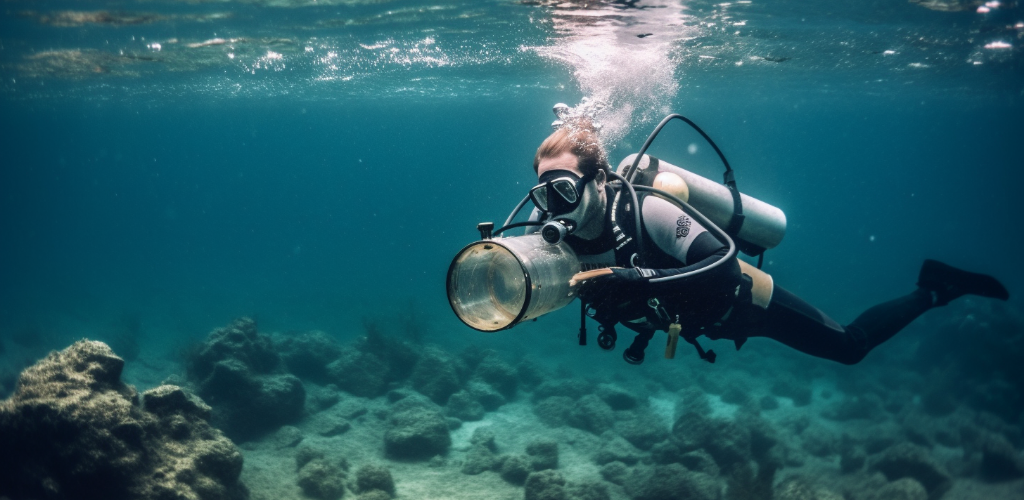Ever wonder why helium is used in diving? The answer lies in science. In this article, we’ll uncover the fascinating role that helium plays in diving and why its use is so important. Whether you’re a diving enthusiast or a curious reader, you’ll find this topic intriguing and full of surprises. So, are you ready to dive deep into this exciting underwater world of science?
Here’s a cool picture of a diver underwater, using a helium mix in their tank. But how did this practice start? Let’s find out.
The Beginning of Using Helium in Diving
The use of helium in diving is not something that happened overnight. It began in the mid-20th century when divers started exploring depths beyond the capabilities of traditional air-based breathing apparatus. The pioneers of this practice were driven by the need to dive deeper and stay underwater longer. The introduction of helium in diving was a game-changer, and it revolutionized the entire diving industry.
Why Divers Use Helium
But why do divers use helium? Well, the answer lies in the unique properties of this gas. Helium is lighter than air, which makes it easier to breathe at great depths. Furthermore, helium doesn’t cause the narcotic effects that nitrogen does under high pressure. This is crucial because nitrogen narcosis can impair a diver’s cognitive functions, making deep dives dangerous.
So, the use of helium in diving isn’t just a matter of choice—it’s a matter of safety and efficiency. But let’s not get ahead of ourselves. We’ll discuss more about the science behind the use of helium in the next section. Stay tuned!
Understanding the Science Behind Helium Use in Diving
Ever wondered why helium is often used in diving? It’s all about the principles of physics and physiology that come into play when you descend beneath the surface of the water. Let’s dive right in!
The Role of Helium in Reducing Nitrogen Narcosis
So, what is nitrogen narcosis? It’s a condition that can affect divers who are breathing air at depth. It’s often described as feeling similar to alcohol intoxication, and it can impair a diver’s decision-making abilities. As you can imagine, that’s not something you want to experience when you’re underwater!
The good news is that this is where helium comes in. Helium molecules are smaller and lighter than nitrogen molecules. This means they are less likely to cause narcosis, making them a safer choice for divers. Isn’t that fascinating?
Helium and Deep Dives
When it comes to deep diving, helium plays an even more crucial role. The deeper you go, the more pressure there is. This increases the density of the air you’re breathing, which can make it harder to breathe. But guess what? Helium, being lighter than nitrogen and oxygen, reduces this density, making breathing easier even at great depths. It’s pretty clear to see why divers switch to helium-based mixtures the deeper they go, isn’t it?
The Risks & Benefits of Using Helium in Diving
Like anything else, using helium in diving has its pros and cons. On the one hand, it reduces the risk of nitrogen narcosis and makes breathing easier during deep dives. On the other hand, helium conducts heat away from the body faster than air, which can make divers feel colder. Furthermore, helium decompresses slower than nitrogen, which means longer decompression stops on the way up.
But don’t let these risks deter you. With proper planning, equipment, and training, diving with helium can be a safe and rewarding experience. Just imagine the incredible underwater worlds you’ll be able to explore!
Helium Mixes in Diving: A Closer Look
Ever wondered about the different helium mixes used in diving? Well, it’s not a one-size-fits-all kind of thing. Depending on the depth and duration of the dive, different mixes such as Trimix and Heliox are used. Let’s break it down.
Trimix is the most common mix used in technical diving. It’s a blend of oxygen, helium, and nitrogen. The main advantage of Trimix is its ability to reduce the effects of nitrogen narcosis, allowing divers to go deeper without feeling the effects of the ‘rapture of the deep’.
On the other hand, Heliox is a blend of helium and oxygen. This mix is often used for very deep commercial and saturation diving where the risks of nitrogen narcosis are particularly high. The lack of nitrogen in this mix helps to prevent narcosis.
So, when is each mix used? Trimix is generally used for recreational technical diving and deep cave diving, while Heliox is primarily used for commercial, scientific, and military diving.
| Mix | Components | Usage |
|---|---|---|
| Trimix | Oxygen, Helium, Nitrogen | Recreational technical diving, deep cave diving |
| Heliox | Helium, Oxygen | Commercial, scientific, and military diving |
Diving Equipment for Using Helium
Diving with helium isn’t just about the gas mix, it’s also about having the right equipment. When diving with helium, you’ll need a few special pieces of equipment and some modifications to your regular diving gear.
Firstly, you’ll need a diving regulator that can handle the high pressures associated with helium diving. These regulators are usually made from materials that can withstand the effects of helium, such as brass or monel.
Secondly, you’ll need a helium analyzer. This is a device that allows you to accurately measure the percentage of helium in your gas mix, ensuring you have the correct blend for your dive.
Finally, you’ll need a decompression computer that can handle multi-gas mixes. This computer will help you plan your dive and manage your decompression stops, taking into account the different gas mixes you’ll be using.
Remember, diving with helium is a serious business, and having the right equipment is crucial to your safety.
Training for Diving with Helium
Have you ever wondered about the training required to dive with helium? It’s not as straightforward as grabbing a tank and jumping in. Diving with helium requires specialized training and certification, which ensures that divers understand the risks, benefits, and best practices associated with helium diving. You can’t just dive in (pun intended) without the proper knowledge and skills.
There are several reputable organizations where you can receive this training. Let’s take a look at some of them.
- Professional Association of Diving Instructors (PADI): As one of the leading diving organizations globally, PADI offers a range of courses, including a specialized course in diving with helium.
- Scuba Schools International (SSI): SSI is another well-known diving organization that provides training in technical diving, including the use of helium.
- Global Underwater Explorers (GUE): GUE offers comprehensive training in technical diving with a focus on safety and conservation.
- Technical Diving International (TDI): TDI is dedicated specifically to technical diving and offers a variety of courses related to diving with helium.
The Future of Helium in Diving
What does the future hold for helium in diving? Well, as technology and research continue to evolve, so do the practices and techniques in diving. There’s ongoing research into more efficient and safer uses of helium in diving, so we can expect some interesting developments in the coming years. But as always, safety and proper training will remain paramount.
Things to Consider Before Diving with Helium
Before we wrap up, let’s revisit some key points to keep in mind before you decide to dive with helium. Remember, safety should always be your first priority.
- Training and Certification: Make sure you have the necessary training and certification to dive with helium. Don’t attempt it without proper preparation.
- Physical Condition: Assess your physical condition and fitness level. Diving, especially with helium, can be physically demanding.
- Equipment: Ensure you have the right equipment, and that it’s in good working condition. Equipment failure can be catastrophic in diving.
- Risks: Understand the risks associated with helium diving and how to manage them.
- Emergency Procedures: Be familiar with emergency procedures. In case of an emergency, knowing what to do can make all the difference.




